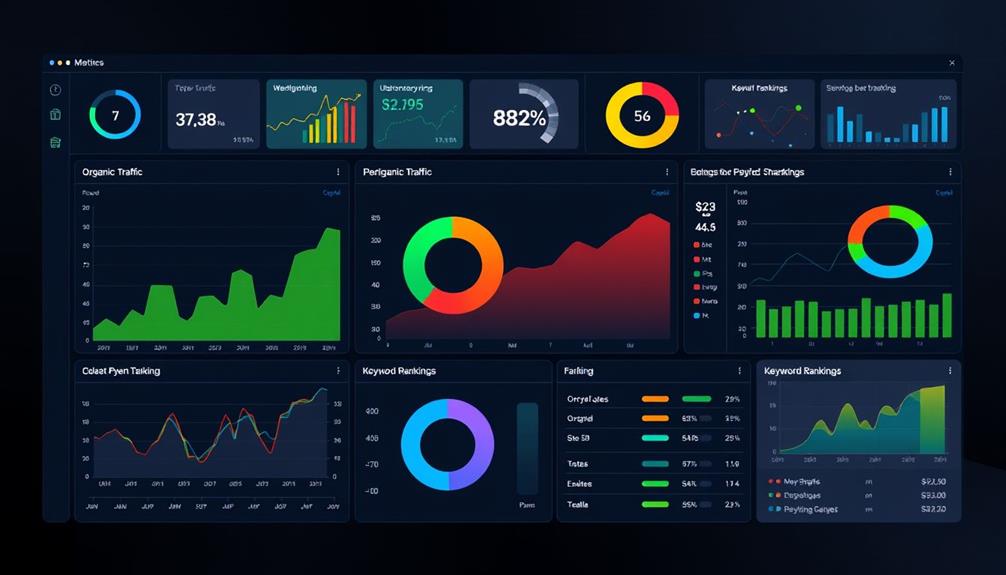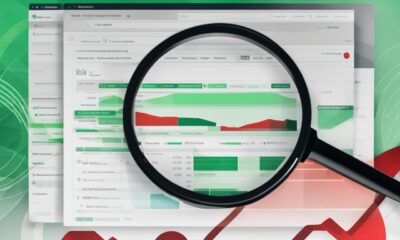Holistic SEO
Google Analytics 4: Navigating the New Analytics Landscape
Familiarize yourself with Google Analytics 4’s innovative features and discover how it can transform your understanding of user behavior and engagement.

Google Analytics 4 (GA4) offers a fresh perspective on user behavior by emphasizing individual interactions and event-based tracking. You'll capture essential actions like clicks and video views, enhancing your understanding of user engagement. Its cross-platform measurement lets you follow user journeys across devices, while predictive metrics help you anticipate trends and refine your marketing strategies. GA4's privacy-first approach guarantees compliance with regulations, safeguarding user data effectively. By adopting GA4, you're positioned to gain deep insights and optimize your campaigns. Stick around, and you'll uncover more tips to fully leverage GA4's powerful features.
Key Takeaways
- GA4 utilizes an event-based tracking system, capturing specific user interactions for deeper insights into engagement and behavior patterns.
- The platform offers cross-platform measurement, allowing businesses to analyze user journeys across both web and mobile applications effectively.
- Predictive analytics in GA4 helps identify trends and optimize marketing strategies based on forecasts of user behavior and potential high-value segments.
- Enhanced user insights and audience segmentation capabilities enable tailored marketing strategies, improving targeting and resource allocation.
- GA4 emphasizes data privacy with compliance measures, user consent management, and robust security protocols to protect user information.
Understanding GA4 Fundamentals
In understanding GA4 fundamentals, you'll notice a significant shift from traditional session-based tracking to a more user-centric approach. This change allows you to dive deeper into user interactions across multiple platforms and devices, providing a thorough view of how users engage with your content.
With GA4's event-based tracking, you can capture detailed actions, which means you can tailor your marketing efforts based on authentic user behavior. The emphasis on data protection regulations also guarantees that user privacy is prioritized as you analyze engagement trends.
One of the standout features of GA4 is its ability to leverage advanced machine learning to generate predictive metrics. This capability enables you to anticipate trends and optimize your marketing strategies effectively.
Plus, with cross-platform measurement, you can track user journeys from acquisition through engagement to conversion, ensuring you understand the entire user lifecycle.
Importantly, GA4 places a strong emphasis on data security and privacy concerns. By relying on first-party data and minimizing the use of third-party cookies, it aligns with evolving privacy regulations, giving you peace of mind while analyzing user data.
Embracing these fundamentals equips you to make more informed decisions and refine your marketing efforts in a privacy-conscious world.
Key Functionalities of GA4
When using GA4, you'll find key functionalities that enhance your understanding of user behavior.
With event-based data collection and user-centric tracking features, you can capture specific interactions that matter most to your business. This approach aligns with the importance of data-driven decisions that enhance budget allocation efficiency.
Plus, cross-platform measurement capabilities allow you to analyze engagement across both web and app, giving you a complete view of your audience.
User-Centric Tracking Features
Leveraging an event-based tracking model, Google Analytics 4 (GA4) captures specific user interactions like clicks and video views to provide a detailed understanding of engagement.
This platform's user-centric tracking features emphasize audience characteristics and behaviors, allowing you to tailor your marketing strategies effectively. With GA4, you can track user journeys seamlessly across web and mobile apps, ensuring thorough insights into user engagement.
Moreover, GA4 harnesses enhanced machine learning capabilities to deliver predictive metrics, helping you anticipate user trends and identify opportunities for better marketing strategies. This means you can make data-driven decisions that resonate with your audience's needs.
Importantly, GA4 adopts a privacy-first approach, ensuring compliance with regulations like GDPR and CCPA.
Event-Based Data Collection
Understanding user interactions becomes easier with Google Analytics 4's event-based data collection model, as it allows you to track specific actions like clicks, downloads, and video views instead of relying solely on pageviews. This shift enables you to gain deeper insights into user behavior, providing a clearer picture of how visitors engage with your content.
By implementing effective keyword clustering and topic clustering, you can enhance user experience and content discoverability, which is essential for interpreting the data collected by GA4.
With GA4, every event can be customized and categorized, so you can track unique actions aligned with your specific goals and KPIs. The platform automatically tracks common interactions, such as page views, scrolls, and outbound clicks, minimizing the need for manual tracking code implementations.
This feature streamlines your analytics setup, letting you focus on interpreting data rather than collecting it. Moreover, you can mark custom events as conversions, offering flexibility in determining which actions matter most for your business objectives.
This capability enhances your understanding of user behavior and helps in measuring performance effectively. Overall, GA4's event-based data collection model is a game changer in the analytics landscape, enabling you to optimize your strategies based on detailed insights from cross-platform tracking.
Cross-Platform Measurement Capabilities
Google Analytics 4 (GA4) revolutionizes how you measure user interactions by seamlessly integrating data from both web and mobile applications.
This cross-platform measurement capability allows you to gain a thorough view of user journeys, helping you understand how users engage with your content regardless of the device they use.
As businesses increasingly rely on efficient credit card processing for e-commerce success, understanding user behavior in this context becomes even more critical.
Here are three key functionalities of GA4 that enhance your analytics experience:
- Event-Based Tracking: GA4 utilizes event-based tracking to capture detailed user actions, giving you a granular understanding of behavior across platforms.
- Real-Time Insights: With real-time tracking, you can adapt your marketing strategies based on current user behavior, ensuring you're always aligned with your audience's needs.
- User Privacy Compliance: GA4 prioritizes user privacy by complying with regulations, ensuring that you can gather valuable insights into user behavior while maintaining data protection.
Advantages of Implementing GA4

When you implement GA4, you'll reveal enhanced user insights that help you understand your audience better.
Its ability to integrate with email marketing software selection enables you to track user interactions across multiple channels.
Its privacy-centric tracking guarantees you're compliant with regulations while still capturing valuable data.
Plus, with predictive analytics, you can anticipate trends and make smarter marketing decisions.
Enhanced User Insights
Many businesses are realizing the significant advantages of implementing Google Analytics 4 (GA4) for enhanced user insights.
With its focus on user interactions, GA4 provides a detailed understanding of engagement, allowing you to tailor your marketing efforts effectively. As businesses face increasing scrutiny on their data practices due to cybersecurity measures, leveraging GA4's features can also help bolster compliance with privacy regulations.
Here are three key benefits:
- Granular Tracking: GA4's event-based tracking captures specific user actions like clicks and video views. This means you get a thorough view of how users engage with your content.
- Predictive Metrics: Thanks to advanced machine learning, GA4 helps you anticipate user trends. By analyzing patterns, you can optimize your marketing strategies and stay ahead of the curve.
- Cross-Platform Measurement: GA4 allows you to track user journeys across devices and channels. This comprehensive view of user engagement helps you understand how users interact with your brand, regardless of where they are.
Moreover, GA4's privacy-first approach guarantees you stay compliant with regulations like GDPR while still gaining valuable insights through first-party data collection.
Privacy-Centric Tracking
As businesses increasingly prioritize user privacy, implementing Google Analytics 4 (GA4) offers a robust solution for privacy-centric tracking. GA4 moves away from third-party cookies, focusing instead on first-party data and event-based tracking, which enhances compliance with regulations like GDPR and CCPA. This shift allows you to gather valuable insights while respecting user privacy.
Moreover, just as an air purifier improves indoor air quality by filtering out pollutants, GA4 filters data to guarantee that only the most relevant information is collected. With GA4, you benefit from advanced machine learning capabilities that analyze user interactions without invasive tracking methods. This approach helps you understand customer behavior while maintaining a privacy-first stance.
Additionally, GA4 includes built-in privacy controls, such as data minimization and user consent management, enabling you to collect only the necessary data and manage permissions effectively. The platform also employs enhanced data encryption measures, assuring that user data remains secure during transit and at rest.
This reduces the risk of unauthorized access and maintains confidentiality, which is vital in today's digital landscape. By adopting GA4, you not only improve your analytics capabilities but also build trust with your users through transparent data practices, ultimately fostering stronger customer relationships and loyalty.
Predictive Analytics Benefits
With GA4's predictive analytics capabilities, you can access a powerful tool for understanding and anticipating user behavior. By leveraging advanced machine learning, you can forecast user behavior and make proactive marketing decisions that drive results.
This approach not only enhances your analytical capabilities but also integrates seamlessly with AI security as a protector, ensuring that your data remains safe while you innovate.
Here are three key benefits of implementing predictive analytics in GA4:
- Enhance Retention Rates: By utilizing metrics like purchase probability and churn probability, you can tailor your strategies to engage users effectively, ensuring they stick around longer.
- Identify High-Value Segments: Predictive analytics helps you pinpoint high-value segments, allowing you to allocate resources efficiently and focus on users most likely to convert.
- Optimize Campaigns: With real-time insights, you can optimize campaigns based on anticipated user actions, improving your ROI by targeting efforts where they matter most.
Integrating these predictive insights enables you to design personalized marketing strategies that align with user needs and preferences.
Seamless Transition to GA4

To guarantee a seamless shift to Google Analytics 4 (GA4), strategic planning is essential right from the start. You'll need to embrace GA4's user-centric approach, focusing on event-based tracking to gain deeper insights into user behavior.
Begin by setting up multiple data streams for both web and mobile apps. This allows you to track user interactions across platforms, ensuring you capture all relevant data with unique measurement IDs. Understanding the key traits of successful SQA engineers can also enhance the quality of your data analysis as you apply meticulous attention to detail and analytical thinking in your approach.
Understanding the built-in reports and admin settings in GA4 is essential, as any changes to your setup can greatly impact data accuracy and reporting. Pay special attention to data retention settings; while GA4 defaults to two months, extending this to 14 months can improve your data analysis capabilities.
Moreover, continuous support and training resources are critical for your team to effectively adapt to GA4's features. By leveraging these insights, you can refine your marketing strategies, driving better engagement and conversions.
Stay proactive in your shift efforts, and you'll find that GA4 can become an invaluable tool in your analytics toolkit.
Exploring User Insights and Reports

Google Analytics 4 (GA4) offers powerful tools for exploring user insights and reports that can transform your understanding of audience behavior.
With GA4, you'll gain a thorough view of your users, allowing you to refine your marketing strategies effectively. This is especially relevant if you're integrating insights from healthy lifestyle blogs, which can provide a wealth of information on user engagement and preferences.
Here are three key features to leverage:
- User Acquisition Report: This report helps you identify which traffic sources bring in the most valuable users, enabling you to focus your efforts on the most effective channels.
- Life Cycle Report: This report encompasses crucial stages of user interaction, including acquisition, engagement, monetization, and retention. It allows you to assess your strengths and weaknesses throughout the user journey.
- Engagement Metrics: By analyzing metrics like session duration, pages viewed, and bounce rates, you can optimize user experience and guarantee your content resonates with your audience.
Additionally, GA4's audience segmentation capabilities let you identify key trends and tailor your marketing strategies based on authentic user behavior.
Privacy Considerations in GA4

Understanding user insights is essential, but privacy considerations are equally important when using Google Analytics 4 (GA4). GA4 adopts a privacy-first approach by shifting away from third-party cookies, focusing on first-party data and event-based tracking. This change enhances compliance with privacy regulations like GDPR and CCPA.
GA4 enforces stricter data retention periods, retaining user data for only two months by default, with a maximum of 14 months recommended. User consent management is critical, utilizing consent mode to guarantee you obtain explicit user consent before collecting data. This aligns with privacy regulations, making certain users are informed and in control.
Data encryption in GA4 protects user data during transit and at rest, safeguarding it from unauthorized access. The platform also offers hands-on privacy controls, allowing you to manage data deletion and retention settings effectively.
Here's a quick overview of key privacy features in GA4:
| Feature | Description | Importance |
|---|---|---|
| Data Retention | Default two months, max 14 months | Compliance |
| User Consent Management | Consent mode for explicit user consent | Aligns with regulations |
| Data Encryption | Protects data during transit and at rest | Guarantees confidentiality |
Conclusion
In the ever-evolving world of digital analytics, adapting to Google Analytics 4 is essential for staying ahead. Remember, "the only constant in life is change." Embracing GA4's innovative features not only enhances your data analysis but also paves the way for informed decision-making. By prioritizing user insights and privacy, you're setting your business up for success in this new analytics landscape. So, immerse yourself and leverage GA4 to access valuable opportunities for growth!
Chris, SEO and Keywords Expert & Author: Chris lives and breathes SEO. With a deep understanding of keyword research and strategy, he’s our go-to guru for everything related to search rankings. Chris has a knack for identifying trends and opportunities in the SEO world, making him an invaluable asset to our team and our clients.
Holistic SEO
Competitor Analysis: Uncovering SEO Opportunities in Your Niche
Find out how competitor analysis can reveal hidden SEO opportunities in your niche and transform your online strategy for better results.

Competitor analysis is essential for uncovering SEO opportunities in your niche. By examining your competitors, you can identify keyword gaps and weaknesses in their strategies. Tools like SEMrush or Ahrefs help you discover high-value keywords and evaluate content gaps, allowing you to create better-targeted content. Don't forget to analyze backlink profiles—this reveals potential link-building opportunities that can enhance your site's authority. Monitoring competitor ranking shifts keeps your strategy relevant and effective. By continuously adapting to these insights, you can drive more organic traffic to your site and improve overall performance. There's more to uncover to optimize your SEO strategy effectively.
Key Takeaways
- Conduct keyword gap analysis to identify high-value keywords your competitors are targeting but you are missing.
- Evaluate competitor content to discover topics and keywords that can enhance your content strategy.
- Analyze backlink profiles of competitors to uncover new link-building opportunities and improve your domain authority.
- Regularly monitor competitor rankings to spot changes and adjust your SEO strategy accordingly.
- Utilize tools like SEMrush and Ahrefs for comprehensive insights into competitor performance and market trends.
Importance of Competitor Analysis
Competitor analysis is essential for anyone serious about improving their SEO strategy. By examining your competitors, you can benchmark your performance against top-ranking websites and identify opportunities to enhance your own SEO efforts. This SEO competitor analysis reveals their strengths and weaknesses, allowing you to uncover keyword gaps in their strategies. By focusing on these gaps, you can create a content strategy that effectively meets user intent and drives organic search results.
Additionally, understanding how AI enhances threat detection in cybersecurity may help inform your approach to safeguarding your content and data.
Moreover, continuous monitoring of competitors is critical, as search engine algorithms frequently change. Staying updated helps you adapt and maintain or improve your search engine rankings. A thorough content analysis of your competitors can highlight successful topics and keywords they target, giving you insight into effective content creation.
Additionally, analyzing competitors' backlink profiles reveals new link-building opportunities. By leveraging their weaknesses and enhancing your authority, you can increase your visibility in search engine results pages.
In short, understanding your competitors not only helps you identify opportunities but also strengthens your overall SEO strategy, making competitor analysis a significant component of your digital marketing efforts.
Identifying Your Competitors

To effectively enhance your SEO strategy, you need to know who you're up against. Identifying your SEO competitors isn't just about pinpointing businesses that sell similar products; it involves recognizing the websites that rank for the same keywords you target.
Start by using tools like SEMrush or Ahrefs to analyze your competitors. These platforms can help you discover which domains rank for your chosen keywords, giving you a clearer picture of the competitive landscape. Additionally, incorporating insights from AI security can provide a more robust defense against potential threats that may undermine your online presence, acting as a silent guardian of sensitive information.
It's important to differentiate between content competitors and domain-level competitors. Content competitors mightn't sell the same products, but they still vie for the same search visibility.
To identify your competitors, you can manually explore search engine results pages (SERPs) or leverage automated tools for a more thorough assessment. This approach can help you highlight up to five key profiles worth analyzing.
Regularly updating your competitor insights is vital. The digital landscape is ever-evolving, and adapting your SEO strategies based on your findings will guarantee you stay ahead.
Analyzing Keyword Strategies

To boost your SEO efforts, start by identifying keyword gaps in your niche.
For instance, exploring dog health and nutrition can reveal valuable keywords related to canine wellness that may not be fully utilized by your competitors.
Analyze your competitors' rankings to see which keywords are driving traffic to their sites but aren't on your radar yet.
This insight can help you target high-potential keywords and refine your strategy effectively.
Identifying Keyword Gaps
Identifying keyword gaps is essential for enhancing your SEO strategy and gaining a competitive edge. By conducting a keyword gap analysis with SEO tools like SEMrush or Ahrefs, you can uncover high-value keywords that your competitors are ranking for but that your site isn't targeting. This insight allows you to develop strategic content that fills those gaps.
Additionally, leveraging testimonials can enhance credibility and trust in your content, making it more appealing to your audience and improving engagement through social proof.
Long-tail keywords often make up 70% of all web searches and can be overlooked by competitors, presenting a golden opportunity for you. These keywords typically have less competition, making it easier for your content to rank. Regularly monitoring your competitors' keyword strategies helps you spot shifts in their focus, enabling you to adjust your targeting promptly.
Utilizing keyword difficulty metrics is vital, as it lets you prioritize efforts on keywords with lower competition scores. This increases your chances of driving organic traffic.
Additionally, analyzing competitors' content and SERP features can inform your content strategy, ensuring you meet user search intent and effectively fill gaps in the market. Embrace these tactics to boost your SEO performance and stay ahead in your niche.
Analyzing Competitor Rankings
Analyzing competitor rankings can uncover valuable insights into their keyword strategies, giving you a clearer path to enhancing your own SEO efforts.
By understanding what keywords your competitors rank for, you can identify SEO opportunities that you might be missing. Additionally, it's essential to recognize the importance of continuous learning and adaptation in the ever-evolving tech landscape, as emphasized in recent trends like hackathons, which foster innovation and collaboration.
Here's how to get started:
- Conduct a keyword gap analysis: Use tools like SEMrush or Ahrefs to pinpoint high-volume keywords your competitors are targeting but you aren't.
- Evaluate their ranking positions: Check where competitors stand for these keywords to prioritize them in your content strategy.
- Understand search intent: Analyze the intent behind their targeted keywords to create content that meets user needs better than theirs.
- Monitor shifts regularly: Keep an eye on how competitor rankings fluctuate, especially after algorithm updates. This will help you adapt your strategies proactively.
Evaluating Content Gaps

Many marketers overlook the importance of reviewing content gaps in their niche, but doing so can open valuable opportunities for growth. By analyzing competitor content, you can identify topics or keywords that they rank for but are missing from your own content strategy.
For instance, exploring topics like juicing techniques can reveal niche areas where you can expand your offerings. This process reveals potential areas for new content creation, especially around long-tail keywords since 70% of online searches fall into this category.
Utilizing tools like SEMrush or Ahrefs for content gap analysis will help you uncover high-volume keywords your competitors leverage. This data is crucial for guiding your content development efforts.
Additionally, a study shows that pages with extensive content, typically over 2,000 words, generally rank higher in search results. Filling these content gaps with well-researched articles can greatly enhance your visibility.
Moreover, regularly reviewing your competitors' content quality and engagement metrics allows you to pinpoint areas where you can improve. By ensuring your offerings provide greater value and relevance, you not only enhance your content strategy but also position yourself for better SEO performance in your niche.
Backlink Profile Assessment

When evaluating your backlink profile, it's crucial to balance quality and quantity.
Consider the importance of quality assurance in software development as you look at where your competitors are getting their links from and consider diversifying your own sources.
Quality Vs. Quantity
In the world of SEO, the debate between quality and quantity in backlinks is vital for your site's success. Focusing on quality backlinks can greatly enhance your backlink profile and improve your rankings in SERPs.
For instance, brands that promote vegan-friendly products often seek backlinks from reputable sources within the plant-based community, which helps boost their credibility.
Here are four key points to reflect on:
- Domain Authority: Links from high-authority sites (above 30) can boost your site's credibility and ranking potential.
- Niche Relevance: Backlinks from relevant sources within your industry not only enhance your site's authority but also show Google that your content is trustworthy.
- Diverse Profile: A diverse backlink profile, including various high-quality links, is more effective for SEO growth than just accumulating a large number of low-quality links.
- Competitor Analysis: Analyzing your competitors' backlink profiles can reveal opportunities for acquiring valuable links from reputable and contextually relevant sites.
Ultimately, while quantity does have its place, prioritizing quality backlinks is essential for effective SEO.
Competitor Link Sources
Analyzing your competitors' backlink profiles can be a game-changer for your SEO strategy. By identifying high-authority link sources that your competitors are leveraging, you can greatly improve your own site's domain authority.
For instance, understanding the benefits of gold investments in retirement accounts can lead to targeted outreach towards financial and investment-related sites. Tools like Ahrefs and SEMrush make it easy to pinpoint specific backlinks your competitors have acquired, allowing you to target similar sites for your link-building efforts.
Utilizing a link intersect tool can uncover common backlinks shared by multiple competitors, revealing valuable outreach opportunities. This helps you focus on high-quality backlinks that have a greater impact on SERP rankings.
Remember, not all links are created equal; evaluating the quality and relevance of your competitors' backlinks is essential. Prioritize links from authoritative domains to enhance your site's credibility.
Additionally, regularly monitoring competitors' backlinks gives you insights into their link-building strategies. By staying informed, you can adapt your tactics effectively and capitalize on emerging opportunities.
In this competitive landscape, leveraging competitor backlink profiles can provide a strategic edge, helping you build a robust link profile that drives traffic and boosts your rankings.
Backlink Diversity Analysis
Boosting your website's SEO performance hinges on understanding backlink diversity. A well-rounded backlink profile is essential for enhancing your domain authority and improving search rankings.
By conducting a thorough competitor analysis, you can uncover valuable SEO opportunities that help shape your own link-building strategies. For instance, just as the value of home security systems highlights the importance of a solid foundation for safety, a diverse backlink profile serves as a cornerstone for robust online visibility.
Here are four key aspects to focus on when analyzing backlink diversity:
- Variety of Sources: Look for backlinks from a mix of blogs, news sites, and industry-specific directories.
- Dofollow vs. Nofollow: Prioritize dofollow backlinks since they pass link equity directly, positively impacting your SEO performance.
- High-Authority Sites: Aim to acquire links from established, high-authority sites, as they lend credibility to your backlink profiles.
- Niche-Specific Links: Don't overlook niche-specific links; they can drive targeted traffic and improve relevance in your industry.
Utilize tools like Ahrefs and SEMrush to visualize competitors' backlink profiles and assess both the quality and quantity of their linking domains.
Technical SEO Evaluation

Understanding the intricacies of technical SEO evaluation is essential for optimizing your website's performance. Focus on key factors like loading speed, mobile responsiveness, and site architecture. These elements are critical not only for improving search engine rankings but also for enhancing user experience.
Remember, Google considers page speed a ranking factor; even a one-second delay can reduce conversions by 7%.
To maximize your SEO opportunities, analyze your site's crawlability and indexing efficiency. With about 66% of pages lacking backlinks, it's important that search engines can access and understand all your content.
Regularly conducting technical audits will help you identify issues such as broken links or duplicate content, as 25% of websites have at least one broken link that can negatively impact performance.
Additionally, consider implementing schema markup. This can enhance your site's visibility in SERPs by enabling rich snippets, potentially improving your click-through rates by 30%.
Tools for Competitor Analysis

When diving into competitor analysis, leveraging the right tools can give you a significant edge in your niche. Here are some top competitor analysis tools that can enhance your SEO insights:
- Semrush: This all-encompassing tool excels in SEO competitive analysis, offering features like backlink analysis, keyword gap analysis, and insights into your organic competitors' strategies.
- Ahrefs: With a robust backlink database, Ahrefs helps you analyze competitors' top-performing pages, revealing valuable content strategies and potential backlink sources for outreach opportunities.
- Moz: Ideal for small websites, Moz's user-friendly interface and free browser extension allow you to conduct effective competitor analysis without breaking the bank.
- SpyFu: This tool specializes in PPC and keyword history, providing insights into competitors' paid advertising strategies and uncovering relevant keyword opportunities based on their investments.
Additionally, consider using BuzzSumo to identify content gaps and trending topics, optimizing your content strategy based on competitors' performance across social media platforms.
Adapting Your SEO Strategy

To stay ahead in the ever-evolving landscape of SEO, you need to adapt your strategy regularly. Conducting competitor analysis is essential for pinpointing shifts in keyword rankings and content performance. This helps you align your approach with current market trends and user intent.
Tools like SEMrush and Ahrefs can assist you in monitoring your competitors' SEO tactics, revealing successful keywords and backlink strategies that you might replicate or enhance.
After significant algorithm updates, take a moment to reassess your competitors' strategies. Focus on any changes in their SEO performance metrics to keep your own tactics competitive.
Additionally, analyze content gaps in their offerings to discover new topics or keyword opportunities that can boost your content strategy and address unmet user needs.
Don't forget to continuously optimize your technical SEO elements. Pay attention to site speed, mobile responsiveness, and on-page factors to improve user experience and search rankings.
Measuring SEO Performance

Measuring SEO performance is essential for fine-tuning your strategy and driving growth. Regular tracking helps you identify fluctuations and opportunities in your niche, especially since 90% of web pages receive no search traffic.
Here are four key metrics to focus on:
- Keyword Rankings: Monitor your keywords consistently to determine which ones drive organic traffic and where you can improve.
- Click-Through Rates (CTR): Measuring click-through rates reveals how well your meta descriptions and title tags resonate with users. Higher CTR often means better alignment with user intent.
- Bounce Rates: A high bounce rate indicates that visitors aren't finding what they expect. This metric serves as a critical indicator of your site's quality and user engagement.
- Domain Authority and Backlink Profiles: Strong backlink profiles greatly correlate with higher rankings. Remember, 66% of pages in search results lack any backlinks.
Utilizing competitive analysis tools like Google Analytics and SEMrush allows for real-time monitoring of organic traffic metrics, helping you assess the effectiveness of your SEO strategy against your competitors' SEO efforts.
Keep measuring, adapting, and improving!
Conclusion
In the end, competitor analysis is like peering through a keyhole into the world of your rivals. When you spot a gap in their keyword strategy or a missed content opportunity, you're not just gaining insight; you're uncovering hidden treasures. By adapting your SEO strategy based on these findings, you can elevate your brand above the competition. Remember, staying one step ahead is essential in the fast-paced digital landscape—so keep that keyhole in sight!
Chris, SEO and Keywords Expert & Author: Chris lives and breathes SEO. With a deep understanding of keyword research and strategy, he’s our go-to guru for everything related to search rankings. Chris has a knack for identifying trends and opportunities in the SEO world, making him an invaluable asset to our team and our clients.
Holistic SEO
Custom Dashboards: Visualizing Your SEO Success
See how custom dashboards can transform your SEO strategy, providing insights that drive success and unlock new opportunities for growth. Discover more inside!

Custom dashboards help you visualize your SEO success by centralizing important metrics like organic traffic, keyword rankings, and conversion rates. You can easily customize widgets to focus on the data that matter most to your business goals. By integrating with over 80 marketing platforms, these dashboards provide a thorough view of your performance. Real-time updates and automated reporting save you time, making decision-making quicker and more efficient. Whether you're tracking unique objectives or essential KPIs, you're set for success. Stick around, and you'll discover even more tips to maximize your SEO dashboard's effectiveness!
Key Takeaways
- Custom dashboards centralize essential SEO metrics like organic traffic and keyword rankings for comprehensive performance tracking.
- Tailored performance metrics enhance clarity and align directly with unique business objectives for effective SEO reporting.
- Real-time data tracking and automated alerts facilitate timely strategy adjustments based on current performance insights.
- User-friendly interfaces and customizable widgets simplify data visualization, making complex metrics accessible to all team members.
- Automated reporting processes streamline communication, providing stakeholders with regular updates on key SEO metrics without manual effort.
Understanding SEO Dashboards
When you immerse yourself in the world of SEO, understanding SEO dashboards is essential for tracking your success. These centralized tools display key performance indicators (KPIs) like organic traffic, keyword rankings, and conversion rates, enabling real-time performance monitoring of your SEO campaigns.
With SEO dashboards, you can visualize your data effectively, making it easier to grasp the health of your strategies. Implementing effective keyword clustering can enhance the insights gained from these dashboards by highlighting the performance of related keywords.
One of the standout features of these dashboards is their customizable nature. You can tailor the metrics shown through adjustable widgets, ensuring you focus on the data that aligns with your specific business goals. This flexibility also allows integration of data from over 80 marketing platforms, giving you a thorough view of both organic and paid search performance within one interface.
Moreover, SEO dashboards automate reporting processes, greatly reducing the time spent on manual data collection. This automation frees you and your team to concentrate on strategy refinement and performance analysis.
Essential Metrics for SEO Success

Crucial metrics are the heartbeat of your SEO strategy, providing essential insights that guide your decision-making. By tracking these key SEO metrics, you can better understand your site's performance and make informed adjustments to improve your results.
| Metric | Importance | How to Measure |
|---|---|---|
| Organic Search Traffic | Indicates the effectiveness of your SEO efforts | Google Analytics, Search Console |
| Keyword Rankings | Shows how target keywords perform over time | SEO tools like SEMrush or Ahrefs |
| Click-Through Rate | Reflects the engagement level of your content | SERP analysis tools |
| Bounce Rate | Reveals user engagement with your content | Google Analytics |
Monitoring organic search traffic helps you gauge how well your SEO efforts drive visitors. Keeping an eye on keyword rankings allows you to identify optimization opportunities. The click-through rate (CTR) informs you about the effectiveness of your meta titles and descriptions, while evaluating the bounce rate indicates how well users engage with your content. Finally, tracking goal conversions links your SEO performance directly to business outcomes, helping you measure success. Custom dashboards can help you visualize these crucial metrics effectively.
Advantages of Custom Dashboards

Custom dashboards give you tailored performance metrics that align perfectly with your unique business goals.
This personalization not only makes data more relevant but also enhances collaboration across your teams, allowing everyone to access insights that matter to them.
By implementing a methodical approach to data visualization, you can guarantee that key metrics are highlighted effectively, similar to best practices in quality assurance processes.
With a clear view of the metrics that drive your success, decision-making becomes more efficient and effective.
Tailored Performance Metrics
Tailored performance metrics offer a powerful advantage in optimizing your SEO strategy, as they allow you to select key performance indicators (KPIs) that align directly with your specific business goals.
By focusing on 5-7 critical KPIs, you can enhance clarity in your SEO reporting dashboard, guaranteeing that only relevant data is tracked for maximum impact. This approach leads to quicker adjustments in strategy based on real-time insights you need.
Furthermore, social proof influences decision-making in your digital marketing efforts, reinforcing the importance of metrics that reflect customer engagement.
Customizable SEO dashboards provide visual elements like graphs and charts, making complex metrics about user behavior and traffic sources more accessible to you and your stakeholders.
With tailored performance metrics, you can track unique objectives such as local SEO rankings or specific conversion goals, which can vary considerably between industries.
Additionally, integrating automated alerts into your dashboard enables proactive management of performance metrics, allowing you to respond promptly to notable changes.
This level of customization not only streamlines your reporting process but also guarantees that you're always focused on achieving thorough SEO success.
Enhanced Data Collaboration
Effective data collaboration transforms how teams approach SEO strategies, making it easier to align efforts with specific marketing goals. Custom dashboards play a vital role in this process by allowing you to share tailored insights that resonate with your KPIs. With real-time access to essential metrics, cross-functional teams can make data-driven decisions quickly, enhancing the responsiveness of your marketing efforts.
Implementing practices from holistic lifestyle approaches can also foster a culture of well-being that enhances team collaboration and focus.
The intuitive drag-and-drop interface of custom dashboards empowers team members to personalize their views and reports effortlessly. This fosters a collaborative environment where everyone can focus on the most relevant data for their roles. Whether you're an executive or a technical SEO specialist, custom dashboards can be designed to meet your specific informational needs, ensuring that every team member has access to the insights that matter.
Moreover, automated reporting features streamline communication, allowing for regular updates and progress sharing among team members. This enhances accountability and transparency in your SEO initiatives, making it easier to track performance and adapt strategies as needed.
Features of Effective SEO Tools

When it comes to choosing SEO tools, five key features can make a significant difference in your success. By focusing on these aspects, you can enhance your custom SEO dashboards and improve your overall marketing performance.
Additionally, just as with investment strategies in a Bitcoin IRA, it's essential to assess the potential risks and rewards when selecting SEO tools.
- Real-time data tracking: Monitor your SEO performance continuously and adjust strategies based on current metrics.
- User-friendly interfaces: Look for tools with intuitive designs and drag-and-drop features that simplify data interpretation for all skill levels.
- Integration capabilities: Verify compatibility with platforms like Google Analytics and Google Search Console to provide thorough insights.
- Automated reporting features: Save time with tools that send regular updates via email or notifications, keeping stakeholders informed without manual effort.
- Key metrics from Google: Prioritize specific KPIs, such as organic traffic and conversion rates, aligning them with your unique business objectives.
Personalizing Your SEO Dashboard

Personalizing your SEO dashboard means you can choose metrics that matter most to your business goals, making it easier to track performance.
With the increasing importance of understanding credit card impacts on personal finances, selecting relevant financial metrics can provide deeper insights into your online presence.
With a user-friendly interface, you can quickly adjust the layout to fit your needs and preferences.
Plus, real-time data updates guarantee you're always working with the latest insights to optimize your strategy effectively.
Tailored Metrics Selection
Choosing the right metrics is essential for creating an SEO dashboard that truly reflects your business goals. Tailored metrics selection allows you to focus on 5-7 key performance indicators (KPIs) that align with your specific marketing objectives. This guarantees clarity and relevance in your data reporting, making it easier to track your progress.
Additionally, integrating tailored metrics can enhance your overall marketing strategy, similar to how email marketing strategies boost customer engagement and outreach.
When designing your custom dashboard, consider incorporating these elements:
- Traffic and Revenue: Monitor how your SEO efforts translate into actual sales.
- Organic vs. Paid Performance: Integrate metrics to gauge overall marketing effectiveness.
- Diverse KPI Tracking: Support various campaigns by customizing your data points.
- Visual Elements: Use graphs and charts for enhanced data interpretation.
- Regular Updates: Refine your metrics based on performance trends to boost your optimization efforts.
An effective SEO dashboard displays the overall health of your digital marketing strategy, allowing you to make informed decisions.
User-Friendly Interface Design
Creating a user-friendly interface for your SEO dashboard can make all the difference in effective data management. With an intuitive user-friendly interface design, you can easily navigate through your dashboard and locate key metrics vital for tracking performance.
Customization features, like drag-and-drop functionality, allow you to personalize your dashboard by selecting and arranging widgets that display the most relevant SEO data for your needs. Additionally, focusing on AI advancements can help enhance the predictive capabilities of your dashboard, providing insights into future trends based on historical data.
Incorporating visually appealing elements such as graphs, charts, and color-coded metrics enhances your comprehension of data, helping you quickly identify trends and anomalies in your SEO performance. A well-designed SEO dashboard often includes prebuilt templates tailored to different marketing roles, so your team can adopt and utilize the tools without extensive training.
This feature streamlines the onboarding process and guarantees everyone is on the same page. Additionally, responsive design guarantees that your dashboard is accessible on various devices, giving you the flexibility to monitor your SEO metrics anytime and anywhere.
Real-Time Data Updates
Real-time data updates elevate your SEO dashboard by ensuring you're always working with the latest performance metrics.
With custom dashboards that integrate with over 80 marketing platforms, you can monitor key performance indicators (KPIs) as data changes. This capability allows you to make informed decisions based on real-time insights, giving you a thorough view of your SEO efforts.
Just like how the effectiveness of home security systems increases safety by providing timely alerts, real-time data keeps your SEO strategies responsive and relevant.
Here's what real-time data updates can do for you:
- Track organic traffic fluctuations as they happen.
- Receive automated alerts for significant changes in metrics that matter.
- Visualize data through customizable widgets for better understanding.
- Adjust strategies promptly based on current keyword rankings and conversion rates.
- Enhance decision-making with the latest insights at your fingertips.
Automating Reporting Processes

Automating reporting processes is a game changer for SEO teams looking to enhance efficiency and focus on strategy. By leveraging an SEO dashboard, you can markedly cut down the time spent on manual reporting. This allows you to dive deeper into strategy rather than getting bogged down with routine tasks.
With customizable metrics displayed in automated reports, you can tailor the data to highlight what matters most to your clients. Furthermore, utilizing user-friendly interfaces in these tools can further streamline your workflow, making it accessible for both beginners and experienced users.
Prebuilt widgets in many SEO dashboard tools make visualizing SEO metrics quick and easy, eliminating the need for extensive manual setup. You'll find that these tools simplify the creation of automated reports, especially with integration with over 80 marketing platforms.
This integration enables thorough data access, giving you a holistic view of your performance. Automated email delivery options guarantee stakeholders receive regular performance updates without any extra effort on your part. This promotes transparency and keeps everyone aligned.
With these advancements, you can focus on interpreting the data and making informed decisions, knowing that your reporting processes are streamlined and efficient. In today's fast-paced digital landscape, automating reporting processes is essential for your SEO success.
Accessibility and Mobile Compatibility

How can you guarantee that you're always in tune with your SEO performance? The answer lies in leveraging custom SEO dashboards that prioritize accessibility and mobile compatibility.
With these interactive and mobile-friendly dashboards, you can monitor your SEO data from anywhere, ensuring that you're never out of touch with your performance metrics.
Here are a few benefits of mobile-friendly dashboards:
- Tailored metrics: Access information that's specific to your needs.
- Convenience: View essential SEO data on any device, anytime.
- Optimized reports: Enjoy clear, actionable data visualization even on smaller screens.
- Quick support: Resolve accessibility issues with fast, round-the-clock support.
- User-friendly: Navigate easily, making it simple to track your progress.
Getting Started With Custom Dashboards

Creating a custom dashboard can greatly enhance your SEO strategy by allowing you to visualize key performance indicators (KPIs) that matter most to your business goals. Start by selecting the SEO metrics that directly align with your objectives, such as organic traffic and keyword rankings.
With an intuitive drag-and-drop editor, you can easily customize your dashboard layout by adding widgets to display your chosen performance data.
Once you've set up your custom dashboards, take advantage of real-time insights to monitor your progress. These dashboards can update automatically, giving you immediate access to critical metrics that inform your decisions.
You can also streamline your workflow through automated reporting, scheduling regular updates so stakeholders receive consistent performance insights without needing manual intervention.
Additionally, custom dashboards support integration with over 80 marketing tools, allowing you to view both SEO and PPC performance in one unified platform.
This thorough overview empowers you to make informed decisions, enhancing your overall marketing strategy. By getting started with custom dashboards, you'll be well on your way to effectively visualizing and optimizing your SEO success.
Conclusion
In the world of SEO, having a custom dashboard is like having a personal roadmap to success. By focusing on essential metrics and leveraging the right tools, you can easily track your progress and make informed decisions. Don't underestimate the power of personalization and automation—it'll save you time and boost your efficiency. So, why not take the plunge and create your own dashboard? With the right setup, you'll be well on your way to hitting the ground running!
Chris, SEO and Keywords Expert & Author: Chris lives and breathes SEO. With a deep understanding of keyword research and strategy, he’s our go-to guru for everything related to search rankings. Chris has a knack for identifying trends and opportunities in the SEO world, making him an invaluable asset to our team and our clients.
Holistic SEO
Predictive SEO: Using AI to Forecast Ranking Opportunities
As AI transforms SEO, discover how predictive strategies can unlock untapped ranking opportunities and revolutionize your content approach. What insights await you?

Predictive SEO uses AI to identify emerging ranking opportunities, changing how you plan your search strategies. By analyzing historical data and current trends, it helps you understand user intent better and align your content with what people are searching for. This proactive approach allows you to discover high-potential keywords early, optimize your resources, and drive higher engagement. Tools like Google Trends and SEMrush enhance your insights, guiding content updates and strategy adjustments. By tapping into these advantages, you can stay ahead of the competition. There's so much more to uncover about maximizing your SEO potential.
Key Takeaways
- Predictive SEO utilizes AI to analyze historical data, forecasting search trends and aligning content strategies with user intent.
- It identifies emerging keywords with less competition, allowing marketers to capitalize on trends before they become mainstream.
- Tools like Google Analytics and SEMrush provide insights for keyword research, user behavior, and performance metrics to enhance content strategies.
- Predictive analytics helps allocate resources efficiently, targeting high-value users and boosting ROI by aligning content with anticipated search behaviors.
- Regular content updates and optimization based on predictive insights improve user engagement and enhance ranking opportunities on search engines.
Understanding Predictive SEO
As you explore the world of Predictive SEO, you'll discover how it harnesses the power of AI to analyze historical data, allowing you to forecast future search trends.
This innovative approach helps you understand user intent more deeply, enabling you to align your content strategy with what potential customers are seeking. By identifying emerging keyword opportunities before they become mainstream, you can proactively create content that resonates with your audience.
Utilizing insights from social media analytics can further enhance your understanding of audience preferences and behaviors.
Predictive SEO shifts your strategy from reactive to proactive, giving you the chance to make timely adjustments in your content and SEO tactics.
You'll find that tools like Google Trends and Google Search Console are invaluable, providing real-time insights into keyword performance and seasonal trends. These insights help you prioritize your SEO efforts based on their potential impact on rankings and guide your budget allocation towards high-ROI opportunities.
Key Tools for Predictive SEO

In the domain of Predictive SEO, having the right tools at your disposal can make all the difference. Google Analytics is essential for tracking website traffic and user behavior. It helps you refine your content strategy based on user preferences and identify high-value content opportunities.
Implementing keyword clustering and topic clustering enhances your SEO strategy by organizing content around central themes, leading to better discoverability.
Google Trends offers real-time insights into search user interests, allowing you to spot seasonal patterns and emerging topics. This can be invaluable for planning your content strategy effectively.
Meanwhile, Google Search Console provides critical performance metrics like click-through rates and impressions. These metrics can help you prioritize which high-potential pages to optimize.
For thorough keyword research, tools like Ahrefs and SEMrush are indispensable. They assist in analyzing keyword volume trends and generating related keywords, ensuring you're targeting the right phrases to boost your rankings.
Additionally, integrating predictive analytics from tools like GA4 can forecast user behavior and potential revenue. This gives you data-driven insights that refine your targeted SEO strategies, helping you stay a step ahead in the competitive landscape.
The Role of AI in SEO

AI-driven insights are transforming how you approach SEO by providing a clearer understanding of user behavior.
With predictive analytics, you can anticipate trends and optimize your content strategy effectively.
This balance between innovation and privacy rights is essential as you refine your SEO tactics.
This not only boosts your website's visibility but also enhances your overall return on investment.
AI-Driven Insights
Harnessing the power of AI-driven insights transforms how you approach SEO by using historical data patterns to predict future search trends.
With predictive analytics tools like Google Analytics 4, you can leverage machine learning to identify high-value users and anticipate their behavior. This includes understanding metrics such as purchase probability and churn probability, guiding your strategy effectively.
As the demand for AI ethics education grows, it's crucial to guarantee that your AI tools are developed with fairness and transparency in mind.
By analyzing user intent behind keywords, AI tools offer tailored content optimizations that resonate with your potential customers. This not only improves engagement but also boosts conversion rates.
Advanced AI algorithms process vast amounts of data rapidly, providing real-time insights that empower you to adjust your strategies proactively. You won't just react to market changes; you'll anticipate them.
Moreover, integrating AI in your SEO efforts helps you discover emerging keywords with lower competition.
These AI-driven insights enable you to stay ahead of market trends and competitor strategies, guaranteeing your keyword research is always relevant and impactful.
In a landscape that evolves quickly, these insights are invaluable for crafting a content strategy that meets your audience's needs and drives results.
Predictive Analytics Benefits
Predictive analytics revolutionizes SEO by leveraging historical data and machine learning to forecast user behavior. By harnessing these insights, you can refine your SEO strategies, ensuring your content resonates with users before trends even emerge.
Additionally, understanding the importance of mastering music production software can enhance your ability to create engaging and relevant content that attracts more traffic.
Here are some key benefits of integrating predictive analytics into your SEO efforts:
- Identifies High-Potential Keywords: Catch trending topics early, allowing you to create content that aligns with user interests.
- Enhances Content Optimization: Tailor your content to meet predicted user needs, improving engagement and satisfaction.
- Improves Resource Allocation: Prioritize tasks based on data-driven forecasts, maximizing your return on investment.
- Targets High-Value Users: Utilize tools like Google Analytics 4 to understand purchase and churn probabilities, focusing on users who matter most.
- Boosts ROI Considerably: Align your content with future search behaviors, leading to increased user experience and interaction on your site.
Applications of Predictive Analytics

In the domain of SEO, predictive analytics offers powerful tools for anticipating trends and audience behavior. By leveraging historical data, you can forecast emerging keyword trends that help you identify high-potential keywords before they gain traction. This proactive approach allows you to optimize your content strategies based on real user behavior and search patterns.
Here's a snapshot of how predictive analytics can enhance your SEO efforts:
| Application | Description | Benefits |
|---|---|---|
| Keyword Trend Forecasting | Identifies high-potential keywords early | Increases organic traffic potential |
| Content Optimization | Aligns content strategies with audience needs | Enhances user engagement and CTR |
| Resource Allocation | Targets areas likely to yield high ROI | Maximizes efficiency and profitability |
Tools like Google Trends and Google Analytics 4 (GA4) provide real-time insights that inform your SEO tactics. By implementing predictive analytics, you not only forecast which content titles will resonate but also drive higher engagement, improving your click-through rates. Embracing these applications will set your SEO efforts apart in a competitive landscape.
Statistical Forecasting in SEO

Analyzing historical performance data alongside current trends enables SEO professionals to forecast future ranking possibilities for specific keywords and content effectively.
By leveraging statistical forecasting, you can tap into valuable insights that guide your SEO strategy. Additionally, understanding market trends can be essential in identifying opportunities for content related to avoiding scams in investments and other financial topics.
Here are key aspects to reflect on when utilizing statistical forecasting in SEO:
- Identify High-Potential Keywords: Focus on keywords that show promise based on historical data and current search trends.
- Prioritize Content Creation: Allocate resources to develop content that aligns with predicted ranking opportunities.
- Monitor Engagement Metrics: Analyze click-through rates (CTR), impressions, and user engagement to refine your forecasts.
- Allocate Resources Wisely: Use forecasting data to optimize your budget and resource distribution for SEO campaigns.
- Adapt to Changes: Regularly update your forecasts with new data to guarantee your strategies remain effective amidst evolving algorithms.
Identifying Ranking Opportunities

Harnessing historical search data and current trends is key to pinpointing ranking opportunities for your SEO strategy. By leveraging predictive analytics, you can anticipate which keywords are likely to gain traction in the near future. Tools like Google Trends help uncover seasonal patterns and emerging keywords that resonate with user interests. This insight allows you to create content proactively, ensuring you're ahead of the curve.
Additionally, understanding the importance of continuous learning, as seen in hackathon trends, can enhance your ability to adapt your SEO strategies effectively.
Analyzing click-through rates (CTR) and user behavior metrics from Google Search Console is essential. It helps you identify high-potential pages that deserve optimization, maximizing your chances of ranking higher.
Additionally, understanding competitive analysis through platforms such as SEMrush reveals gaps in competitors' keyword strategies. This knowledge highlights areas where you can introduce new content to capture valuable ranking opportunities.
Optimizing User Experience

When you optimize user experience, you're not just improving how visitors interact with your site; you're boosting your SEO performance too.
Enhancing site navigation, personalizing content delivery, and streamlining page load speed can make a notable difference in user engagement and conversions.
For instance, the presence of security systems can greatly enhance user experience by providing peace of mind and a sense of safety, which can lead to longer site visits and higher engagement rates increased safety and peace of mind.
Enhancing Site Navigation
Enhancing site navigation is essential for creating an intuitive user experience that keeps visitors engaged. By leveraging AI tools like Google Analytics 4, you can analyze user behavior patterns to identify drop-off points and streamline pathways. This proactive approach improves overall site navigation, ensuring users find what they need quickly and efficiently.
Additionally, a methodical approach to site structure, similar to what successful SQA Engineers employ in their testing processes, can greatly enhance navigation efficiency.
Here are some strategies to enhance site navigation:
- Utilize predictive analytics to forecast the impact of changes in site architecture.
- Implement structured data to provide clear context and improve visibility in search engine results.
- Regularly test navigation based on predictive insights to adapt to evolving user preferences.
- Focus on reducing bounce rates by optimizing pathways that guide users seamlessly.
- Prioritize modifications that are likely to enhance user satisfaction and increase conversion rates.
Personalizing Content Delivery
Personalizing content delivery is essential for optimizing user experience and keeping visitors engaged with your site. By utilizing predictive analytics, you can analyze historical data to anticipate user preferences and tailor content to their specific interests. This approach not only enhances the relevance of your content but also fosters a deeper connection with your audience.
For instance, understanding dog health and nutrition can help you create content that resonates with pet owners who are concerned about their dogs' well-being.
When you leverage tools like Google Analytics 4 (GA4), you can identify high-value users and predict their content preferences based on user behavior. This allows you to create dynamic content recommendations that adapt in real-time, increasing engagement and overall satisfaction.
Furthermore, predictive SEO can help you forecast seasonal trends and shifts in user behavior. By delivering timely and relevant content, you can align your offerings with your audience's evolving needs.
Implementing AI-driven insights into your content strategy is vital for understanding drop-off points in user journeys. This understanding enables you to adjust content delivery effectively, ultimately improving conversion rates.
Streamlining Page Load Speed
User experience hinges not just on relevant content but also on how quickly that content loads. If your site takes longer than three seconds to load, you risk losing over half of your mobile users.
To improve your page load speed and guarantee a better user experience, focus on optimizing your content with the following strategies:
- Optimize images: Compress and resize images for faster loading times.
- Leverage browser caching: Store frequently accessed files locally to reduce load times for returning visitors.
- Reduce server response times: Choose a reliable hosting provider that minimizes delays.
- Minimize JavaScript and CSS: Remove unnecessary code to streamline loading processes.
- Utilize Google PageSpeed Insights: Get actionable recommendations to enhance performance based on Core Web Vitals metrics like LCP, FID, and CLS.
Enhancing Content Strategy

Revealing the potential of predictive SEO can transform your content strategy greatly. By harnessing predictive analytics, you can analyze historical search data to forecast trending topics, enabling you to create relevant content ahead of demand peaks.
This proactive approach means you'll stay ahead of the curve, guaranteeing your content resonates with your audience when it matters most.
Utilizing tools like Google Trends allows you to identify seasonal patterns and emerging keywords, so you can align your content calendar with anticipated interests. By focusing on high-potential keywords with strong commercial intent, you'll guide your content creation toward topics that drive traffic and conversions.
Incorporating AI-driven insights from platforms like Google Analytics 4 refines your strategy by predicting user behavior and engagement metrics. This guarantees your content not only attracts but also engages your target audience effectively.
Moreover, regularly updating existing content based on predicted trends and user intent can markedly improve your search rankings. In an ever-evolving digital landscape, staying relevant is vital, and predictive SEO equips you with the tools to achieve just that.
Embrace predictive SEO to elevate your content strategy and boost your online visibility.
Future Trends in Predictive SEO

As you explore future trends in predictive SEO, you'll see how evolving algorithms will adapt to better analyze user behavior and preferences.
This shift will empower you to develop data-driven content strategies that resonate with your audience.
Plus, with enhanced user experience insights, you'll be able to create more engaging and relevant content that meets their needs.
Evolving Algorithm Adaptation
While the digital landscape continuously evolves, businesses must stay ahead by embracing predictive SEO strategies that adapt to changing algorithms.
Predictive analytics is essential for understanding and anticipating algorithm updates, ensuring your content remains relevant and authoritative. By leveraging machine learning, you can analyze historical data to identify patterns that inform your future strategies.
Here are some key trends to keep in mind for evolving algorithm adaptation:
- Natural Language Processing (NLP): Enhances content relevance by improving search engines' understanding of user intent and context.
- Voice Search Optimization: Focuses on conversational queries to align with the rise of AI-driven search experiences.
- Structured Data Implementation: Utilizes schema markup to help search engines comprehend content context and improve visibility.
- Continuous Monitoring: Tracks algorithm updates and user engagement metrics to refine your predictive SEO strategies.
- Proactive Adaptation: Adjusts your content and strategies in response to anticipated changes in user behavior.
Data-Driven Content Strategies
In a world where data drives decision-making, adopting data-driven content strategies has become essential for successful predictive SEO. By leveraging predictive analytics, you can analyze historical search data to forecast future ranking opportunities. This insight allows you to tailor your content strategies to align with emerging search trends, guaranteeing you're always a step ahead.
Utilizing tools like Google Trends and Google Analytics 4 (GA4) empowers you to identify seasonal trends and high-potential keywords. With this information, you can create proactive content that resonates with your target audience, meeting their specific needs and preferences. This approach not only enhances user engagement but also improves your conversion rates.
Additionally, by focusing your resources on areas identified through predictive models, you maximize your ROI in content marketing efforts. Continuous monitoring and refinement of your content based on predictive insights guarantee that your strategies remain relevant, adapting to shifts in search engine algorithms and user behavior.
Embracing data-driven content strategies positions you to thrive in the ever-evolving digital landscape, keeping your brand competitive and visible.
Enhanced User Experience Insights
Enhanced user experience insights play an essential role in the future of predictive SEO. By leveraging AI to anticipate user intent, you can create relevant content that engages users before trends even emerge. This proactive approach fosters greater satisfaction and retention.
Here's how enhanced user experience can transform your strategies:
- Anticipate user intent: Predict what users are searching for, allowing you to deliver content that meets their needs.
- Predictive insights: Use historical data to identify potential drop-off points in user journeys, enabling timely adjustments to your content.
- Seasonal trend predictions: Prepare relevant content in advance, ensuring that you're ready during peak interest periods.
- Enhanced personalization: Dynamically adjust content based on predicted user behavior, leading to a more tailored experience.
- Utilize tools like GA4: Leverage predictive metrics to forecast user behavior and refine your content strategies accordingly.
Best Practices for Implementation

Implementing predictive SEO effectively hinges on utilizing the right tools and data. Start by leveraging platforms like Google Trends and Google Analytics 4 (GA4) to identify emerging keywords and forecast user behavior based on historical data. This foundation sets the stage for your predictive analytics strategy.
Use AI for SEO to continuously monitor your website's performance. This allows you to make timely adjustments to your SEO tactics in response to shifting trends and user preferences.
Prioritize high-potential content opportunities by analyzing competitor strategies, pinpointing gaps in their keyword targeting to gain a competitive edge in your niche.
Regularly refresh and optimize your existing content using insights from predictive analytics. This guarantees your content aligns with anticipated search trends, keeping it relevant in search results.
Lastly, foster collaboration between SEO teams and data analysts. This partnership enhances the interpretation of predictive insights, guaranteeing that your strategies are informed by both quantitative data and qualitative insights.
Conclusion
In the ever-evolving landscape of SEO, harnessing predictive analytics is like having a crystal ball that reveals your path to success. By leveraging AI and optimizing your strategies, you can forecast ranking opportunities and stay ahead of the competition. Embrace these tools, enhance user experience, and refine your content strategy to guarantee your efforts yield fruitful results. As you implement best practices, you'll not only navigate the digital terrain but also thrive within it, turning potential challenges into triumphs.
Chris, SEO and Keywords Expert & Author: Chris lives and breathes SEO. With a deep understanding of keyword research and strategy, he’s our go-to guru for everything related to search rankings. Chris has a knack for identifying trends and opportunities in the SEO world, making him an invaluable asset to our team and our clients.
-

 Holistic SEO2 months ago
Holistic SEO2 months agoHolistic Local SEO Tactics for Small Businesses
-

 Holistic SEO2 months ago
Holistic SEO2 months agoHow to Establish Dominance in SEO through Topical Authority
-

 Holistic SEO2 months ago
Holistic SEO2 months agoKeyword Research (SEO) for Tattoo Artists
-

 Learning Center3 months ago
Learning Center3 months ago52 Niches with Good Crossover Potential Explored
-

 Learning Center2 months ago
Learning Center2 months agoThe Future of SEO: Leveraging the Google Search Generative Experience
-

 Holistic SEO2 months ago
Holistic SEO2 months agoHolistic SEO Food Blogger
-

 Keyword Research2 months ago
Keyword Research2 months agoMastering SEO: How to Analyze Keyword Results and Find Easy Keywords
-

 Technical SEO3 months ago
Technical SEO3 months agoWhat Is the Seo Title Length





















